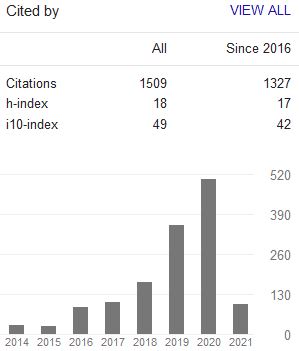THE FORMALISATION OF ISLAMIC ATTIRE IN PADANG, WEST SUMATRA
Abstract
This study examines the formalisation of Islamic attire among Minangkabau people – particularly among school students in Padang, West Sumatra – in the spirit of the regional autonomy of post-Soeharto Indonesia. It focuses on the conceptualisation and enforcement of the Mayor’s policy concerning Islamic attire for students in the Mayoral Decree (No. 451.422/2005) in line with the rampant Shari>`ah-influenced by-laws throughout West Sumatra. I argue that the formalisation of Islamic attire has been unproductive in terms of promoting Islamic precepts because veiling is an ever-contested concept within the complex Muslim social structure. The imposition of this ‘contested concept’ has led to veiling becoming an ‘imposed choice’ that has assumed a formal meaning as proper religious attire for the wearer. Instead of enhancing religious awareness, the imposition of Islamic attire on students in public schools has failed to encourage a personal awareness of religious and cultural identity in them.
Keywords
Full Text:
PDFReferences
Abdullah, T., Summerfield, A., Summerfield, J. & University of California Los Angeles. “Fowler Museum of Cultural History.” in Walk in Splendor: Ceremonial Dress and the Minangkabau. Los Angeles: UCLA Fowler Museum of Cultural History, 1999.
Abdullah, T. Identity Maintenance and Crisis of Identity in Minangkabau. Jakarta: Lembaga Ekonomi dan Kemasyarakatan Nasional, 1978.
----------. Sejarah Lokal di Indonesia: Kumpulan Tulisan. Yogyakarta: Gadjah Mada University Press, 1985.
Abu-Lughod, L. “The Romance of Resistance: Tracing Transformation of Power Through Bedoin Women.” American Ethnologist, 17 (1990): pp. 41-55.
Alatas, A. & Desliyanti, F. Revolusi Jilbab: Kasus Pelarangan Jilbab di SMA Negeri se-Jabotabek, 1982-1991. Jakarta: Al-I’tishom Cahaya Umat, 2001.
Anon., Peringatan 55 Tahun Diniyah Putri Padang Panjang. Jakarta: Ghalia Indonesia, n.d.
Berlinerblau, J. “Toward a Sociology of Heresy, Orthodoxy and Doxa.” History of Religions, 40 (2001): pp. 327-351.
Bensman, J. &. Givant, M. “Charisma and Modernity: The use and abuse of a concept.” in Glassman, R. M. & Swatos, WH. Jr (Eds.). Charisma, History and Social Structure. New York: Greenwood Press, 1986.
Boland, B. J. The Struggle of Islam in Modern Indonesia. Leiden: The Hague-Martinus Nijhoff, 1971.
Bowen, J. R. Islam, Law, and Equality in Indonesia: an Anthropology of Public Reasoning. Cambridge, UK: New York, Cambridge University Press, 2003.
Brenner, S. “Reconstructing self and society: Javanese Muslim women and the veil.” American Ethnologist, 23 (1996): pp. 673-697.
Dobbin, C. E. Islamic Revivalism in a Changing Peasant Economy: Central Sumatra, 1784-1847. London: Curzon Press, 1983.
Driver, G. R., Miles, S. J. C. & ASSYRIA. The Assyrian laws.
El Guindi, F. Veil: Modesty, Privacy and Resistance. Oxford, UK: New York, NY, Berg., 1999.
Feillard, A. “The Veil and Polygamy: Current Debates on Women and Islam in Indonesia.” Moussons, 99 (1999): pp. 5-28.
Foucault, M. The History of sexuality. New York: Pantheon Books, 1978.
Gramsci, A. History, Philosophy and Culture in the Young Gramsci. St.Louis: Telos Press, 1975.
Haba, J., Mulyani, L. & Pusat Penelitian dan Pengembangan Kemasya¬rakatan dan Kebudayaan (Indonesia). Nagari dan Krama Desa: Studi mengenai Pemilihan Struktur antara Perilaku Elit dan Masyarakat Lokal di Sumatra Barat dan Nusa Tenggara Barat. Jakarta: Pusat Penelitian Kemasyarakatan dan Kebudayaan Lembaga Ilmu Pengetahuan Indonesia (PMB-LIPI), 2001.
Kuntowijoyo. Muslim tanpa Masjid: Esai-esai Agama, Budaya, dan Politik dalam Bingkai Strukturalisme Transendental. Bandung: Mizan, 2001.
Marbun, S. F. & MD, Mahfud. Pokok-pokok Hukum Administrasi Negara. Yogyakarta: Liberty, 1987.
Munir, D. & Padang (Indonesia) Dinas Infokom. 1 tahun Walikota & Wakil Walikota Padang: Drs. H. Fauzi Bahar, M.Si & Drs. H. Yusman Kasim: 18 Februari 2004-17 Februari 2005. Padang: Dinas Infokom Kota Padang, 2005.
Parker, L. “Uniform Jilbab.” Inside Indonesia. July-September 2005.
Safwan, M. & Proyek Inventarisasi dan Dokumentasi Sejarah Nasional (Indonesia). Sejarah Kota Padang. Jakarta: Departemen Pendidikan dan Kebudayaan, Direktorat Sejarah dan Nilai Tradisional, Proyek Inventarisasi dan Dokumentasi Sejarah Nasional, 1987.
Sihombing, H. “Hukum Adat Minangkabau Mengenai Tungku Tiga Sejarangan dan Tali Tiga Sepilin.” in A. A. Navis (ed.). Dialektika Minangkabau. Padang: Genta Singgalang Press, 1983.
Weber, M., Roth, G. & Wittich, C. Economy and Society: an Outline of Interpretive Sociology. Berkeley: University of California Press, 1978.
Whalley, L. A. “Virtuous Women, Productive Citizens: Negotiating Tradition, Islam, and Modernity in Minangkabau, Indonesia.” Unpublished PhD thesis, University of Illinois, Urbana-Champaign, 1993.
Newspapers
Haluan, 11 February 2005.
Haluan, 12 June 2006
Haluan, 21 March 2005.
Indopos, 05 June 2005.
Indopos, 27 May 2005.
Media Indonesia, 26 August 2005.
Padang Ekspress, 21 May 2005.
Tempo, 22 May 2005.
DOI: 10.15642/JIIS.2009.3.1.69-96
Refbacks
- There are currently no refbacks.
Indexed by:
Journal of Indonesian Islam (ISSN 1978-6301 and E-ISSN 2355-6994) is published by the Postgraduate Program (PPs) and the Institute for the Study of Religion and Society (LSAS), State Islamic University (UIN) of Sunan Ampel Surabaya.
Journal of Indonesian Islam by http://jiis.uinsby.ac.id/index.php/JIIs/index is licensed under a Creative Commons Attribution-ShareAlike 4.0 International License.
Copyright ©2020 State Islamic University (UIN) of Sunan Ampel Surabaya. Powered by Public Knowledge Project OJS.







